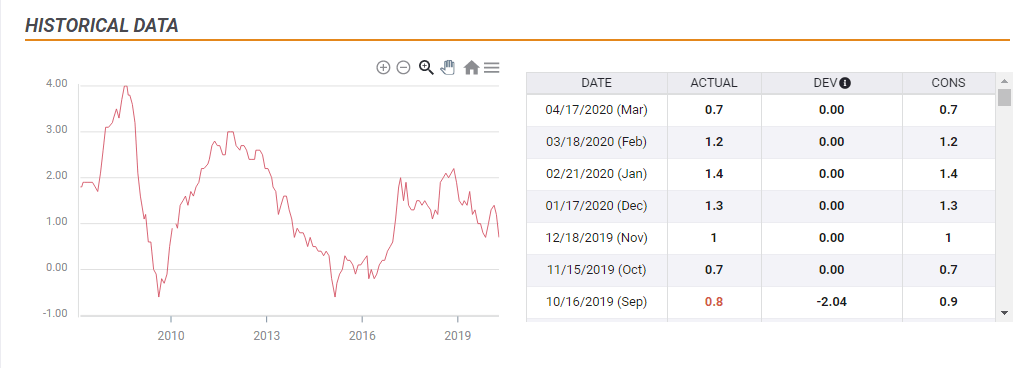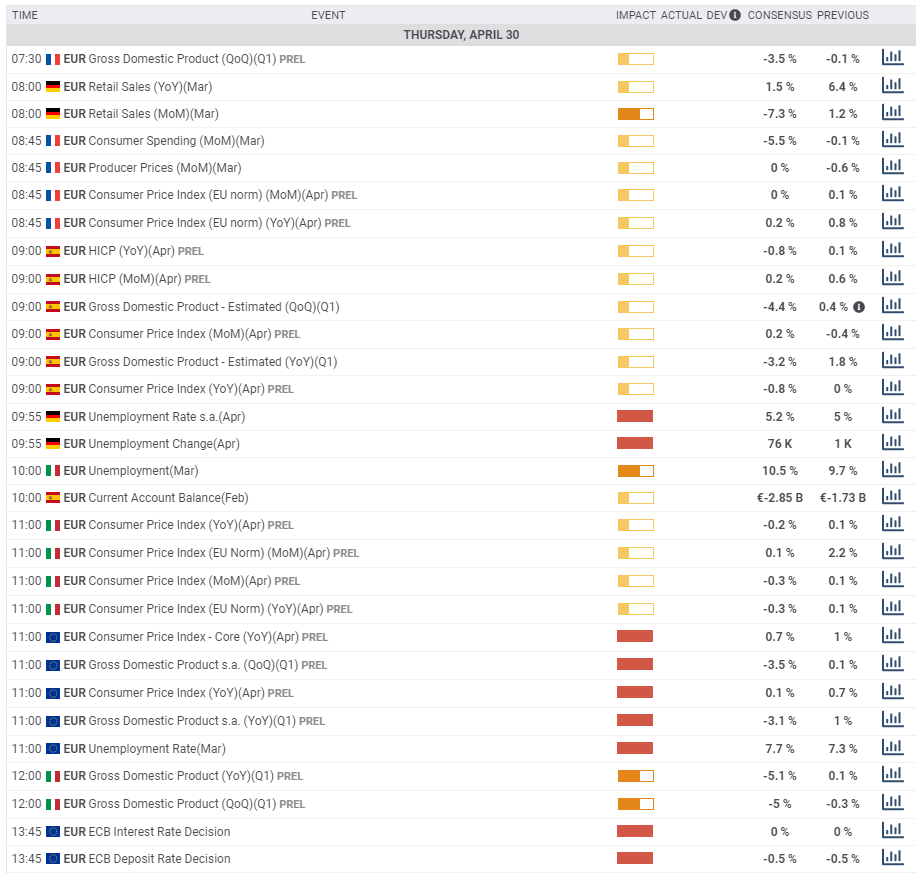- Eurozone GDP is set to plunge by 3.5%, quarterly, in the first view of coronavirus carnage.
- Economists project a collapse in inflation in April to the verge of deflation.
- Downbeat figures may trigger ECB action, and boost EUR/USD.
When the dead mounted in northern Italy in late February – that is when markets began noticing. The big bulk of hard data published at the end of April – just before the European Central Bank announces its rate decision – will provide hard evidence of coronavirus' carnage.
Plunge in output
European countries entered lockdowns throughout March and ground their economies to a halt. That will likely be reflected in devastating Gross Domestic Product figures in the first quarter of 2020.
While the range of economists' estimates is wider than usual, there is no doubt that the currency zone suffered a significant contraction in the first quarter – and that the second quarter will likely be far worse. The economic calendar is pointing to a dive of 3.5% quarterly and 3.1% yearly.
The publication for the whole eurozone is preceded by figures from France, the second-largest economy, which is set to suffer along the lines of the entire bloc. Spain, the fourth-largest economy that imposed a strict lockdown, is next up, and contraction is set to hit 4.4% quarterly. Italy, the third-largest economy, may have seen output fall by 5%.
Germany, the "locomotive" of the eurozone, releases figures next week, yet the pandemic has not hurt it as much as other large economies. The eurozone statistic will likely have the most significant impact, yet the publication competes with inflation data.
Falling prices
The ECB officially has "one needle in the compass" – headline inflation. Annual Consumer Price Index stood at 0.7% in March and core CPI at 1%, far from the "2% or close to 2%" target of the central bank. It is set to become much worse in April's preliminary release – falling to 0.1% on the headline and 0.7% on the core.
If CPI drops below 0% – outright deflation, it would ring alarm bells in Frankfurt, where the ECB is based, and across the continent. Falling prices cause consumers to wait for them to further decline, weighing on the economy.
Also here, the statistics for the entire bloc are preceded by reports from the largest countries, yet these carry less weight.
Employment data are also due out throughout the morning, with the eurozone jobless rate set to climb from 7.3% to 7.7% for March. However, it is a somewhat lagging figure and with so many data points coming out, it is probably at the bottom of the list.
ECB context – why bad news is good news
Christine Lagarde, President of the European Central Bank, has been a proponent of monetary support as well as fiscal stimulus – supporting coronabonds. Lagarde and her colleagues will announce their decision less than three hours after the all-European figures are released and will certainly take them into account.
The bank announced the Pandemic Emergency Purchase Program( PEPP) – a new bond-buying program worth €750 billion in an extraordinary meeting in March. IT has been since deploying them at a rapid clip and without substantial fiscal action, that money may run out.
Will the ECB enhance its efforts? The chances are low, but devastating data may convince it otherwise. If the bank acts sooner rather than later – such as in its June meeting when it publishes new forecasts – governments could borrow and spend. Stimulating the battered eurozone economies would boost the euro.
Lagarde and fellow doves at the bank have a battle with the hawks led by Jens Weidmann, President of the German Bundesbank. Northern countries and their representatives at the ECB want to avoid financing indebted countries without justification.
Yet if the situation is dire, these hawks may change their minds. Therefore, the worse the data comes out, the higher the chances for stimulus and the better for the euro.
All in all, the redder these figures are, the greener the euro may go:
Conclusion
Eurozone growth, inflation, and also employment figures will probably be worrying amid the coronavirus crisis – and get worse in the coming months. However, as this big bulk of statistics is released ahead of the ECB decision, devastating data may trigger more stimulus and boost the euro.
More: ECB Preview: The only game in town could be in lockdown, three mostly negative EUR/USD scenarios
Information on these pages contains forward-looking statements that involve risks and uncertainties. Markets and instruments profiled on this page are for informational purposes only and should not in any way come across as a recommendation to buy or sell in these assets. You should do your own thorough research before making any investment decisions. FXStreet does not in any way guarantee that this information is free from mistakes, errors, or material misstatements. It also does not guarantee that this information is of a timely nature. Investing in Open Markets involves a great deal of risk, including the loss of all or a portion of your investment, as well as emotional distress. All risks, losses and costs associated with investing, including total loss of principal, are your responsibility. The views and opinions expressed in this article are those of the authors and do not necessarily reflect the official policy or position of FXStreet nor its advertisers. The author will not be held responsible for information that is found at the end of links posted on this page.
If not otherwise explicitly mentioned in the body of the article, at the time of writing, the author has no position in any stock mentioned in this article and no business relationship with any company mentioned. The author has not received compensation for writing this article, other than from FXStreet.
FXStreet and the author do not provide personalized recommendations. The author makes no representations as to the accuracy, completeness, or suitability of this information. FXStreet and the author will not be liable for any errors, omissions or any losses, injuries or damages arising from this information and its display or use. Errors and omissions excepted.
The author and FXStreet are not registered investment advisors and nothing in this article is intended to be investment advice.
Recommended Content
Editors’ Picks

Gold trades near record-high, stays within a touching distance of $3,100
Gold clings to daily gains and trades near the record-high it set above $3,080 earlier in the day. Although the data from the US showed that core PCE inflation rose at a stronger pace than expected in February, it failed to boost the USD.

EUR/USD turns positive above 1.0800
The loss of momentum in the US Dollar allows some recovery in the risk-associated universe on Friday, encouraging EUR/USD to regain the 1.0800 barrier and beyond, or daily tops.

GBP/USD picks up pace and retests 1.2960
GBP/USD now capitalises on the Greenback's knee-jerk and advances to the area of daily peaks in the 1.2960-1.2970 band, helped at the same time by auspicious results from UK Retail Sales.

Donald Trump’s tariff policies set to increase market uncertainty and risk-off sentiment
US President Donald Trump’s tariff policies are expected to escalate market uncertainty and risk-off sentiment, with the Kobeissi Letter’s post on X this week cautioning that while markets may view the April 2 tariffs as the "end of uncertainty," it anticipates increased volatility.

US: Trump's 'Liberation day' – What to expect?
Trump has so far enacted tariff changes that have lifted the trade-weighted average tariff rate on all US imports by around 5.5-6.0%-points. While re-rerouting of trade will decrease the effectiveness of tariffs over time, the current level is already close to the highest since the second world war.

The Best brokers to trade EUR/USD
SPONSORED Discover the top brokers for trading EUR/USD in 2025. Our list features brokers with competitive spreads, fast execution, and powerful platforms. Whether you're a beginner or an expert, find the right partner to navigate the dynamic Forex market.

